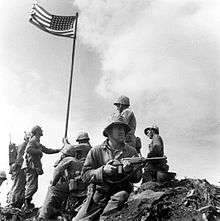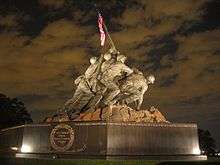Harold Schultz
Harold Henry Schultz (January 28, 1926 - May 16, 1995) was a United States Marine corporal who helped raise the second U.S. flag (a replacement flag) on top of Mount Suribachi on February 23, 1945, during the Battle of Iwo Jima in World War II.
The Marine Corps announced on June 23, 2016, that Schultz is one of the flag-raisers in Joe Rosenthal's iconic photograph Raising the Flag on Iwo Jima. The Marine Corps also stated after reviewing the identities of the six second flag-raisers in the photograph that former Navy corpsman John Bradley (deceased) who was thought to be in the photo since April 1945, was not.[1][2] Schultz is the second flag-raiser in the photograph who was not originally identified as one. In 1947, after a Marine Corps investigation, it was determined that Corporal Harlon Block was in the photograph. The Marine Corps War Memorial in Arlington, Virginia, depicts the second flag-raising on Mount Suribachi by six Marines.
U.S. Marine Corps
Schultz entered the Marine Corps Reserve on December 23, 1943 from Detroit, Michigan. He was a member Easy (E) Company, 2nd Battalion, 28th Marine Regiment, 5th Marine Division which was activated in 1944 and began training at Camp Pendleton before the division was transferred to Camp Tarawa near Hilo, Hawaii for further training to prepare for the invasion of Iwo Jima. In January 1945, the division left Hawaii for Iwo Jima. He participated in the battle of Iwo Jima which began on February 19, helped raise the replacement U.S. flag atop Mount Suribachi on February 23, was wounded in action on March 13, and was honorably discharged with the rank of corporal on October 17, 1945.
Iwo Jima
The 4th and 5th Marine Division assault forces landed Iwo Jima on February 19, 1945. The 28th Marines of the 5th Division landed on the southeast part of the island closest to where Mount Suribachi was located. The 28th Marines mission was to capture Mount Suribachi on the first day but that did not happen due to heavy fighting. The 28th Marines reached the east side of the mountain on February 21 and by the evening of February 22, had most of the mountain surrounded. On the morning of February 23, a 40-man patrol from the Second Battalion, 28th Marines, climbed up Suribachi and succeeded in capturing it and raising the American flag which was replaced hours later by a larger flag. Schultz who was a member of this patrol and present at the first flag raising, helped raise the replacement flag on Suribachi. He was wounded in action (WIA) on March 13 and was evacuated off the island.
First flag raising

At 8 am on the morning of February 23, 1945, a 40-man combat patrol (mostly from Third Platoon, Easy Company, 2nd Battalion, 28th Marines) that included two Navy corpsmen, climbed up Mount Suribach to seize and occupy the crest. First Lieutenant Harold Schrier, E Company's executive officer, who volunteered to lead the patrol, was to raise the battalion's American flag to signal that the mountaintop was captured. Along the way up, there was a small number of Japanese sniper shots. When Schrier and his men reached the rim there was a skirmish which they soon overcame. After an iron water pipe was found and used for a flagstaff, the American flag was tied to it by Lt. Schrier. Sergeant Henry Hansen, and Corporal Charles Lindberg. Once the flag was tied on, the flagstaff was taken to the highest position on the crater to be raised. The flag was raised by Lt. Schrier, Platoon Sergeant Ernest Thomas, and Sgt. Hansen.[3] Due to the terrific winds on the mountaintop, Navy corpsman John Bradley (one of two corpsmen in the patrol) who was assigned to Easy Company's Third Platoon, pitched in to help the flagstaff stay vertical.
Seeing the raising of the National colors immediately caused loud cheers from the Marines, sailors, and Coast Guardsmen on the south end of Iwo Jima and from the men on the ships near the beach. Staff Sergeant Lou Lowery, a Marine photographer for "Leatherneck Magazine" and the only photographer who accompanied the patrol, took several photos of the first flag before and after it was raised. The last photo he took was before a Japanese grenade almost killed him (his camera was broken). The Marine Corps did not allow any of these photos to be published until 1947, in Leatherneck Magazine.
Second flag raising
.ogg.jpg)

Some two hours after the first flag was raised on Mount Suribachi, Marine Corps leaders decided that in order for the American flag to be more easily seen from the ships, beaches, and land off and around the north end of Mount Suribachi (where most of the Japanese soldiers were located and heavy fighting would occur), another larger replacement flag should be flown on Mount Suribachi (the Second Battalion's commander, Lt. Colonel Chandler Johnson, also wanted to secure the flag for his battalion). Sgt. Michael Strank a squad leader from Second Platoon, E Company, was ordered by E Company's commander to take three Marines from his squad up to the top of Mount Suribachi to raise the second flag. Strank chose Cpl. Harlon Block, Pfc. Ira Hayes, and Pfc. Franklin Sousley. Pfc. Rene Gagnon, a Second Battalion runner (messenger) for E Company, was ordered to take the replacement flag up the mountain and return with the first flag which was flying on top.
Once Gagnon, and Strank with his three Marines who were carrying supplies made it to the top, Hayes and Sousley found a Japanese pipe to attach the flag on. The replacement flag was attached to pipe and the flagstaff positioned close to the other flag. Under Lt. Schrier's orders, the replacement flag was raised by Strank, Block, Hayes, Sousley, Gagnon, and Schultz (Strank called Gagnon and Schultz to help),[4] at the same time the first flag came down. Schultz was a member of the 40-man patrol that had climbed to the top of the volcano. In order to keep the flagstaff in a vertical position, rocks were added around the base and a rope was tied to it and staked down in three spots (Bradley assisted the Marines using the rope).
Associated Press combat photographer Joe Rosenthal who climbed up the mountain with two Marine photographers (Marine Sgt. Bill Genaust and Pvt. Robert Campbell) in time to photograph the first flag while it was still up, took a black and white photograph of the second-flag raising which first appeared in many newspapers on Sunday, February 25, 1945. Other Marine photographers, an Army photographer (from Yank Magazine), and a Coast Guard photographer, had also climbed up Suribachi to take pictures after the first flag was raised and some of these photographers also took pictures of each flag flying. Sgt. Genaust who filmed the second flag-raising in color, was killed in action in a cave on March 4 (MIA, March 3). Lt. Colonel Chandler was killed on March 8.
Marine Corps War Memorial
The Marine Corps War Memorial (also known as the Iwo Jima Memorial) in Arlington, Virginia which was inspired by Rosenthal's photograph of the second flag raising on Mount Suribachi was dedicated on November 10, 1954.[5] Harold Schultz is depicted as the fifth bronze statue from the bottom of the flagstaff with the 32 foot (9.8 M) bronze statues of the other five flag-raisers on the monument (Franklin Sousley is depicted as the third bronze statue from the bottom of the flagstaff).[6]
President Dwight D. Eisenhower attended the memorial's dedication ceremony and sat upfront with Vice President Richard Nixon and Deputy Secretary of Defense Robert Anderson. Also in attendance were two of the three surviving flag-raisiers depicted on the monument, Ira Hayes and Rene Gagnon, who were seated together with John Bradley (who was misidentified as being the third surviving "flag-raiser" depicted on the memorial (the third bronze statue from the bottom of the flagstaff) in the front rows of seats along with relatives of the those who were killed in action on the island.[7] Speeches were given by Richard Nixon, Robert Anderson who dedicated the memorial, and Lemuel Shepherd, the 20th Commandant of the Marine Corps who presented the memorial to the American people.[8] Inscribed on the memorial are the following words:
- In Honor And Memory Of The Men of The United States Marine Corps Who Have Given Their Lives To Their Country Since 10 November, 1775
Military awards
Schultz is entitled to the following military decorations and awards:
| Purple Heart Medal | |
| Combat Action Ribbon[9] | |
| Navy Presidential Unit Citation | |
| American Campaign Medal | |
| Asiatic-Pacific Campaign Medal with one 3⁄16" bronze star | |
| World War II Victory Medal |
See also
References
- ↑ USMC Statement on Marine Corps Flag Raisers/, Office of U.S. Marine Corps Communication, 23 June 2016
- ↑ https://www.navalhistory.org/2016/07/01/john-bradleys-account-of-the-iwo-flag-raising Naval History Blog, U.S. Naval Institute, July 1, 2016 (May 9, 1945 interview with John Bradley)
- ↑ Rural Florida Living. CBS Radio interview by Dan Pryor with flag raiser Ernest "Boots" Thomas on February 25, 1945 aboard the USS Eldorado (AGC-11): "Three of us actually raised the flag"
- ↑ USMC Statement on Marine Corps Flag Raisers, Office of U.S. Marine Corps Communication, 23 June 2016
- ↑ Marine Barracts Washinton, D.C.
- ↑ USMC Statement on Marine Corps Flag Raisers, Office of U.S. Marine Corps Communication, 23 June 2016
- ↑ "Memorial honoring Marines dedicated". Reading Eagle. Pennsylvania. Associated Press. November 10, 1954. p. 1.
- ↑ "Marine monument seen as symbol of hopes, dreams". Spokane Daily Chronicle. Washington. Associated Press. November 10, 1954. p. 2.
- ↑ Combat Action Ribbon (1969): Retroactive from December 7, 1941: Public Law 106-65, October 5, 1999, 113 STAT 508, Sec. 564
